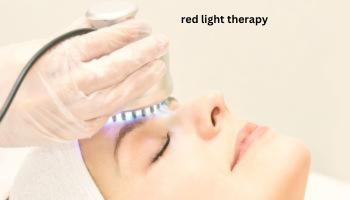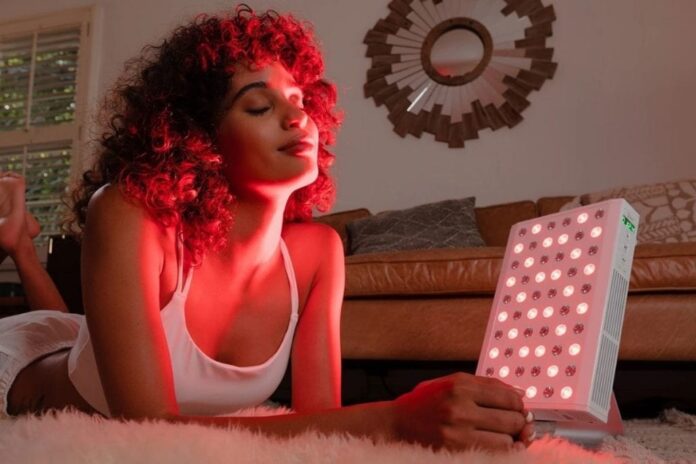Red Light Rehabilitation:
A new treatment called red light therapy (RLT) is showing promise in the treatment of scars, wrinkles, redness, acne, and other aging symptoms. Many researchers believe that in order to verify its efficacy as a treatment, additional clinical trials are required. Ask your doctor if red light therapy is a possibility for your skin condition if you’re interested in it.
How Does Red Light Therapy Operate? What Is It?
Red light therapy provides both medical and cosmetic benefits by using a particular natural light wavelength. It is a light-emitting diode (LED) combination that produces heat and infrared light.
Dermatologist Lindsey Zubritsky, MD, explains that wavelengths of light, or colors of the rainbow, are divided into a spectrum that includes ultraviolet (UV) rays, infrared (things we cannot see), and visible light. Low wavelengths of red light are used in red light therapy because they are thought to be bio-active in human cells and have the ability to directly and specifically influence and enhance cellular function.
It’s crucial to remember that this specific kind of light is not the same as UV radiation from the sun or tanning beds, and there isn’t a higher risk of UV damage or cancer.2.
Brondon P, Stadler I, Myakishev-Rempel M, et al. A preliminary investigation into the safety of red light phototherapy for cancer-related tissues.
Red light has the ability to reach the dermis, the deepest layer of skin, as well as our outermost layer. This is the location of our collagen, elastin, and other vital proteins. Our cells take in red light photons and transform them into energy. The aforementioned energy can subsequently incite the synthesis of collagen, elastin, and adenosine triphosphate (ATP), thereby generating additional energy.
What Advantages Does Red Light Therapy Offer?
Getting acne: Acne frequently comes with some degree of inflammation. Red light therapy reduces bacteria and oil production on the skin, as well as helping to soothe and lessen redness. According to Zubritysky, it is perfect for treating mild to moderate acne.
According to a study published in 2018, “acne and sensitive skin are often associated due to the involvement of an impaired skin barrier in both conditions, which can be further aggravated by certain topical acne treatments…therefore, a nontopical, chemical-free treatment that is well tolerated by patients with self-perceived sensitive skin for use in the treatment of acne is highly desirable.”
Preventive Aging: Red light therapy is widely used for its anti-aging properties, and for good reason—many studies have demonstrated its beneficial effects on aging. According to a 2019 study published in The Journal of The American Academy of Dermatology, red light therapy stimulates the skin’s synthesis of hyaluronic acid, collagen, and elastin. Thus, low-level red and infrared light treatments are ideal “opportunities for daily, at-home treatments for patients with photo-aging and photo-damaged skin” because they can help with skin laxity, fine lines, pore size, texture, and wrinkles.1.
Healing of Wounds: Do you want a scar to go away? Red light therapy improves circulation and increases oxygenation in the area, which can help reduce scar tissue.4
Cold Sores: If you have oral herpes simplex virus (cold sores) that come back frequently, red light therapy can hasten the healing process and lessen pain.5.
Hair Loss: Alopecia—more especially, androgenetic alopecia, or male and female pattern hair loss—has been shown in certain studies to respond well to red light therapy.Six
Photobiomodulation for alopecia management: mechanisms of action, patient selection, and viewpoints, Hamblin MR. 2019;12:669–678 in Clin Cosmet Investig Dermatol. Cite as 10.2147/CCID.S184979
It is recommended to be used for milder cases and in the early stages of hair loss as it may not be effective for everyone.
What skin conditions are being treated with red light therapy?
Red light therapy is recommended as a treatment for a number of prevalent skin issues, such as:
- enhance the healing of wounds.
- Cut down on stretch marks
- Diminish age spots, fine lines, and wrinkles.
- Boost the texture of your face.
- ameliorate rosacea, eczema, and psoriasis.
- Enhance the scars.
- Boost skin damaged by the sun.
- help those who suffer from androgenic alopecia grow more hair.
- enhance acne.
Does red light therapy work well?

The majority of experts state that they are unsure if RLT is useful for all of its stated purposes. The majority argue that more research is necessary even though the studies that have been published thus far suggest some promise for specific conditions. Red light therapy is still a relatively new treatment that is gaining popularity. However, there isn’t enough data available right now to justify the majority of uses.
One of the most reliable methods of assessing a product’s efficacy is through randomized, placebo-controlled trials. This means that for the treatment of the same condition, a predetermined number of individuals with similar characteristics (age, weight, race, gender, etc.) are given either the study treatment or a placebo (a fake or “sham” treatment).
Is red light treatment secure?
Red light therapy doesn’t seem to have any negative effects and is safe, at least when used as prescribed and for a brief period of time. Compared to certain topical skin treatments, this therapy is less harsh, less invasive, and less toxic. RLT does not use ultraviolet (UV) light, which is known to cause cancer, like that found in the sun or tanning booths.
However, there’s a chance that products used improperly, such as too frequently or not in accordance with instructions, could harm your skin or eyes, if they’re not protected. Red light therapy devices’ long-term safety is still unknown.
Visiting a dermatologist or a licensed, experienced cosmetic therapist is your safest course of action. A dermatologist can confirm the state of your skin.
Conclusion:
For many skin concerns, red light therapy is a little-known but promising treatment. Among other cosmetic concerns, it treats wrinkles, acne, hyperpigmentation, and inflammation. RLT has the potential to treat a wide range of illnesses and diseases associated with inflammation, though further research is required.
Numerous health and wellness establishments offer RLT booths, beds, lamps, and handheld devices for purchase at varying price points.
When used appropriately, this therapy has no negative side effects and is safe for all skin types. Nonetheless, consult a board-certified dermatologist for medical advice if you have a serious skin condition. Seeing a licensed provider will yield the best outcomes and reduce the likelihood of negative outcomes.
For more Information visit our Homepage.



